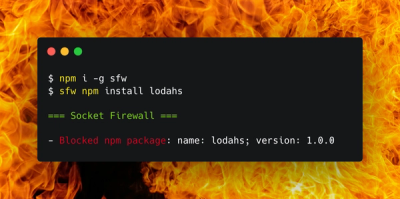
Security News
Package Maintainers Call for Improvements to GitHub’s New npm Security Plan
Maintainers back GitHub’s npm security overhaul but raise concerns about CI/CD workflows, enterprise support, and token management.
@dreipol/lighthouse-config
Advanced tools
Centralized location to hold the @dreipol/lighthouse-runner default configuration
npm i @dreipol/lighthouse-config
This module simply provides some default configuration. You can extend this config to your flavour. Therefore no setup for this module is required.
| field | type | default | value |
|---|---|---|---|
| paths | Array | ['/'] | Array of url paths. All these routes are tested and reported |
| chromeFlags | Array | ['--window-size=1200,800'] | Array of additional chrome flags. See all |
| folder | string | ./dreihouse-reports | Define location to store the reports |
| disableEmulation | boolean | true | Applay device emulation |
| disableThrottling | boolean | true | Disable Network and CPU throttling |
| preAuditScripts | Array | ['html'] | Current available persisters are html json and `html-dashboard |
| report | Object | Lighthouse report configurations. See exmaples |
In order to handle login forms, or do other modifications of the page before lighthouse audits the page,
you can add some preAuditScripts in the config. Those scripts are executed right before lighthouse starts.
These scripts have to implement the PreAuditScriptInterface interface.
Before execution of this script, the browser instance will already be on the inital url, passed in the execute method of Dreihouse
Here is an example of such login script
module.exports = {
execute:async(logger, page) {
await page.waitForSelector('#username', { visible: true });
await page.waitForSelector('#password', { visible: true });
const usernameInput = await page.$('#username');
const passwordInput = await page.$('#password');
await usernameInput.type(process.env.LOGIN_USERNAME);
await passwordInput.type(process.env.LOGIN_PASSWORD);
await passwordInput.press('Enter');
}
}
Now in your config file you can load the login script
...
saveReport: true,
budget: {
...
},
preAuditScripts: [
require('your/login/script.js'),
],
reporters: {
modules: [
...
paths: [
'/',
],
folder: "./dreihouse-reports",
tag: 'desktop',
chromeFlags: ['--window-size=1280,1024'],
disableEmulation: true,
disableThrottling: true,
budget: {
dreipol: 100,
seo: 90,
performance: 90,
pwa: 70,
accessibility: 70,
'best-practices': 70,
},
report: {...}
You can extend the base configuration with your own configuration. This is done by creating a new config file in your project and include the base config via require. Then you can edit the Object the way you want
Example for local mobile config:
let mobileConfig = require('@dreipol/lighthouse-config/config/base/desktop');
mobileConfig.chromeFlags = ['--window-size=320,480'];
mobileConfig.disableEmulation = false;
mobileConfig.disableThrottling = false;
module.exports = mobileConfig;
FAQs
Basic lighthouse config
We found that @dreipol/lighthouse-config demonstrated a not healthy version release cadence and project activity because the last version was released a year ago. It has 4 open source maintainers collaborating on the project.
Did you know?

Socket for GitHub automatically highlights issues in each pull request and monitors the health of all your open source dependencies. Discover the contents of your packages and block harmful activity before you install or update your dependencies.

Security News
Maintainers back GitHub’s npm security overhaul but raise concerns about CI/CD workflows, enterprise support, and token management.

Product
Socket Firewall is a free tool that blocks malicious packages at install time, giving developers proactive protection against rising supply chain attacks.

Research
Socket uncovers malicious Rust crates impersonating fast_log to steal Solana and Ethereum wallet keys from source code.